

Identifying and working with dyslexic students. Teaching English and Planning Lessons. How to get started as an online teacher of English. Have you thought about teaching English online? Emma Segev gives some practical tips and useful websites for getting started in one of our top five articles of all time, illustrated by artist Jamie Johnson. When I first started teaching in 2004, I was sceptical about the effectiveness of online teaching, but since then I have accumulated a lot of experience. I'd like to share with you a few things I've learned along the way. Getting started Contrary to popular opinion, I recommend starting your online teaching career by working for an established company. Training videos. This is a full archive of all the explanatory/training videos we’ve produced, plus video footage of some of our presentations and interviews.
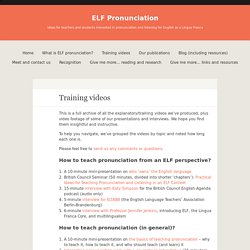
We hope you find them insightful and instructive. To help you navigate, we’ve grouped the videos by topic and noted how long each one is. Please feel free to send us any comments or questions. How to teach pronunciation from an ELF perspective? A 10-minute mini-presentation on who ‘owns’ the English languageBritish Council Seminar (50 minutes, divided into shorter ‘chapters’): Practical Ideas for Teaching Pronunciation and Listening in an ELF Context15-minute interview with Katy Simpson for the British Council English Agenda podcast (audio only)5-minute interview for ELTABB (the English Language Teachers’ Association Berlin-Brandenburg)6-minute interview with Professor Jennifer Jenkins, introducing ELF, the Lingua Franca Core, and multilingualism How to teach pronunciation (in general)?
ELF in teacher training – presentations of our research. Practice Makes Perfect. Cambridge English Write & Improve. Principles, Guidelines and the CEFR. The ELP’s essential features, for example its three parts: Language Passport, Language Biography, Dossier its explicit aims, notably to foster linguistic and cultural diversity, to promote intercultural learning, to support lifelong plurilingual learning, to develop learner autonomy, to provide a transparent and coherent means to record communicative competence (relating to the Common European Framework of Reference for Languages) that is recognisably European The Annotated Principles and Guidelines describe the above points in detail.
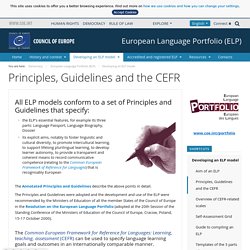
The Principles and Guidelines were adopted and the development and use of the ELP were recommended by the Ministers of Education of all the member States of the Council of Europe in the Resolution on the European Language Portfolio (adopted at the 20th Session of the Standing Conference of the Ministers of Education of the Council of Europe, Cracow, Poland, 15-17 October 2000). Read more The CEFR describes in a comprehensive manner: Cohesion. Cohesion is one of the two qualities that give a written or spoken text unity and purpose, the other being coherence.

It refers to the use of linguistic devices to join sentences together, including conjunctions, reference words, substitution and lexical devices such as repetition of words, collocations and lexical groups. ExampleThe second sentence above has cohesive devices such as conjunctions (and, such as, including), articles (the), references (it), and collocations (join _____ together, lexical groups). In the classroomCohesion is an extensive area and can be approached at a discrete item level, e.g. practising article use or differing synonyms. Daily News for Kids, Students & Teachers. Circle games. They are mostly used with young learners, but teenagers will play them and so will the right kind of adult class: one that doesn't take itself too seriously.
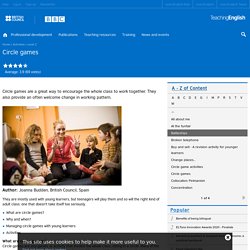
What are circle games? Teacher talking time. Teacher talking time (TTT) is the time that teachers spend talking in class, rather than learners.

It can be compared with student-talking time. One key element of many modern approaches is to reduce the amount of TTT as much as possible, to allow learners opportunities to speak, and learn from speaking. ExampleA teacher monitoring students working in groups completing a discussion will probably do fairly little talking, limiting themselves to clarification of the task and offering language when requested. The same teacher leading an inductive grammar presentation will probably talk more, as they explain, illustrate and check understanding. Angela Watson's The Cornerstone For Teachers. How to teach the UN's development goals, and why.
The Sustainable Development Goals (SDGs) are 17 goals defined by the United Nations to tackle the world's biggest problems by 2030.

Emily Reynolds of our schools team explains why it is in students' interest to know about the goals, and how teachers can teach them. Why teach the UN's latest development goals? The goals form a useful lens through which to look at the most pressing global issues. Hundreds of millions of people don't have enough food to eat; women still earn less than men and have fewer rights; plant and animal species are rapidly vanishing; and the gap between rich and poor is indeed getting wider. GSE Teacher Toolkit. Training Courses. FCE Speaking Test Part 3 Useful Phrases (with examples) Getting Started.
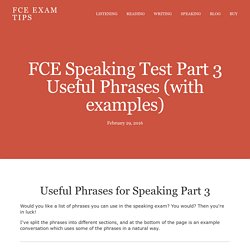
Timmy Time - The Official Timmy Time Website. Lexical exploitation of texts. Día Europeo de las Lenguas > Teachers > Teaching materials. ESL worksheets, handouts, lesson plans and resources for English teachers. PET Speaking: Home – Writefix.com. There are four parts in the PET speaking test: Part 1: general introductions;Part 2: discussion about a situation;Part 3: photographs; andPart 4: discussion about a topic.

You can find up-to-date information about the PET exam at the Cambridge ESOL website. Part 1 In Part 1 the examiner will ask you questions. Whitepaper TD 72dpi FINAL ONLINE VERSION. Classroom Activities to Encourage Critical Thinking – Greek Teachers in England. The ability to think critically is especially important in our day and age as more and more students seem to be lacking the skill to filter the information they retrieve on a daily basis.

As digital citizens, they acquire knowledge from online resources which might be limited or superficial at times. Thus, the tricky question posed is how we, as educators, can spur critical thinking and authentic communication so that they can later develop 21st-century competencies, such as collaboration and problem-solving. What is Critical Thinking?
(11) BBCLearning. Teaching English to learners with Special Educational Needs (SENs) – Myths and realities. ‘I know I have children with special educational needs in my class, I want to help them and we are supposed to promote inclusion, but I really am not sure how to do this’ Vera, primary teacher from Spain ‘Some of the children in my class are really badly behaved, they can’t sit still, don’t finish their work and are always calling out.
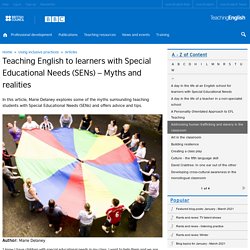
I think they might have a learning difficulty, but I don’t know what to do’ Kris, secondary teacher from Poland Do you feel like these teachers? Dyslexia Aware Counselling in North London. Macmillan Education: ELT courses, digital solutions and educational materials. Laura Patsko - Integrating pronunciation with a coursebook-based syllabus. UK Reading Experience Database - Home. What did United Kingdom residents and British subjects living or travelling abroad read between the invention of the printing press in 1450 and the end of the Second World War in 1945? How, and in what circumstances did they read? Search or browse our database to find out…